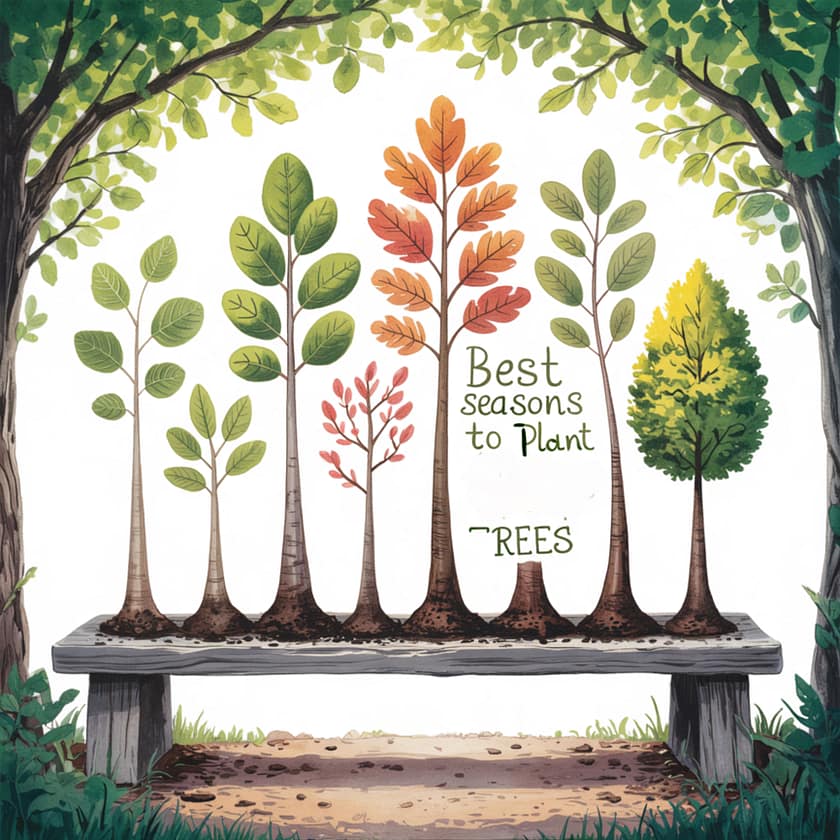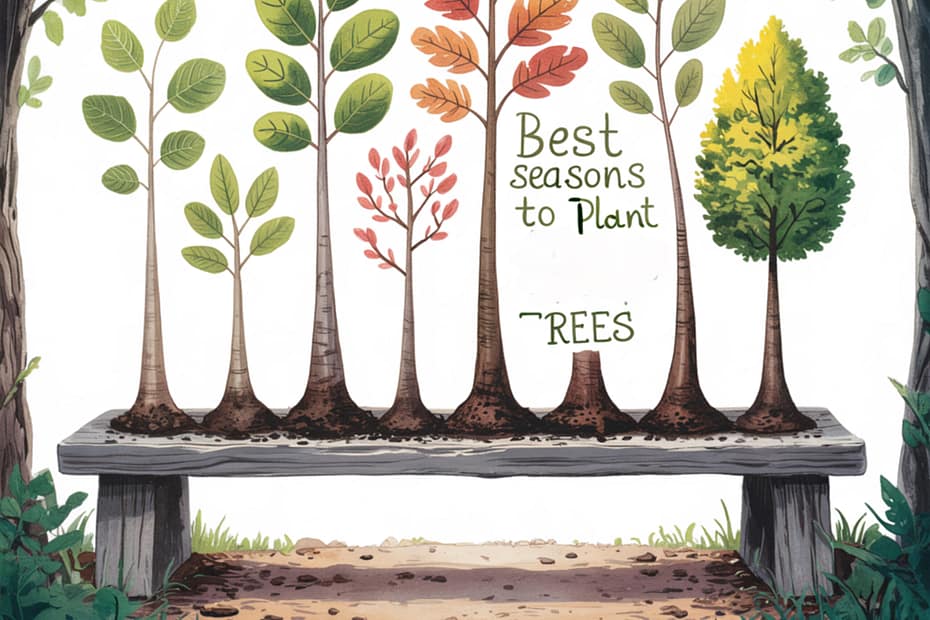Best Seasons To Plant Different Types Of Trees
Timing plays a crucial role in tree planting. It ensures that trees not only survive but thrive in their new environment. Planting trees at the right time significantly impacts their health, growth rate, and overall success. By understanding the best seasons to plant different types of trees, you set yourself up for a green, flourishing landscape.
Planting at the wrong time of year can stress young trees, exposing them to extreme weather conditions they can’t handle. This makes them more susceptible to disease, pests, and even death. By matching your tree planting efforts with the best season, you give your trees a fighting chance to establish strong roots and become resilient against the elements.
Trees planted during their optimal season experience less shock and stress. Think of it as nature’s way of giving them a head start. They have better access to water and nutrients, making it easier for them to acclimate. Additionally, seasonal planting can reduce the need for frequent watering and intensive care, which is a significant win for both the trees and the planter.
Successful tree planting is about more than digging a hole and dropping in a sapling. It requires planning and understanding of local climates, soil conditions, and seasonal variations. By considering these factors, you’re making informed decisions that boost the likelihood of your trees thriving and contributing to a healthier environment.
Spring: The Season for Flowering Trees
Spring breathes new life into our surroundings, making it the ideal season for planting flowering trees. During spring, the soil is warming up, and there’s a consistent supply of moisture from rain. These conditions create the perfect environment for young trees to take root and start growing vigorously.
Flowering trees bring bursts of color and a sense of renewal. Some popular options include dogwoods, magnolias, cherry blossoms, and redbuds. These trees not only add aesthetic value but also support local ecosystems by providing nectar and shelter for pollinators like bees and butterflies.
When planting in spring, it’s essential to choose a spot with well-draining soil and adequate sunlight. Flowering trees typically thrive in areas where they receive at least six hours of direct sunlight per day. Also, make sure to dig a hole that’s twice as wide and just as deep as the tree’s root ball. This allows the roots to spread out easily and establish firmly.
Watering is key during the first few weeks after planting. Keep the soil consistently moist but not waterlogged. Mulching around the base of the tree can help retain moisture and regulate soil temperature. Be cautious of overwatering, which can lead to root rot.
Having the right tools makes the process smoother. A sharp spade, a sturdy garden hose, and some quality mulch are your best friends during spring planting. If you’re unsure about the best time to plant specific species in your area, local nurseries are excellent resources for advice.
Summer: Planting Fruit and Nut Trees
Summer is often underrated for tree planting, but it’s actually a fantastic season for establishing fruit and nut trees. During summer, the warmer soil encourages root development, helping these trees settle in and start producing delicious yields sooner.
Certain fruit trees, like apples, peaches, and figs, thrive when planted in summer. Nut trees such as walnuts, almonds, and pecans also benefit from the warm conditions. These trees need a lot of sunlight, which summer delivers in abundance.
One of the best parts about planting fruit and nut trees in summer is the availability of quality stock at nurseries. You’re likely to find vigorous, healthy trees ready to be planted and grow. Plus, planting in summer gives them a full growing season to become established before winter sets in.
It’s important to stay on top of watering, as young trees can dry out quickly in the summer heat. Deep watering once a week generally works well, ensuring the water reaches down to the roots. Mulch is your ally here too, helping conserve moisture and keep the soil cool.
When choosing a location, select a spot with plenty of sunlight and good drainage. Fruit and nut trees are sunshine lovers and perform best when they’re not sitting in soggy soil. Regularly check for pests and diseases, as the warmer weather can bring them out in full force.
Don’t forget to stake your newly planted trees if you’re in a windy area. Staking provides extra support until the roots are strong enough to hold the tree upright on their own. Summer planting may require a bit more hands-on care initially, but the reward of a bountiful harvest makes it worthwhile.
Fall: Ideal Time for Deciduous Trees
Fall is a sweet spot for planting deciduous trees. The cooler temperatures paired with the still-warm soil create perfect conditions for root establishment. Think of it as nature’s way of giving these trees a head start before winter.
Common choices for fall planting include maples, oaks, and birches. These trees drop their leaves in autumn, making them less demanding in terms of water and nutrients during their initial establishment. When spring arrives, they’re ready to burst with new growth.
Site selection is crucial. Deciduous trees usually require a spacious area to accommodate their broad canopy and deep root system. Make sure the spot receives ample sunlight and has good soil drainage. Dig a hole that’s twice as wide and just as deep as the root ball to give the roots room to spread.
Watering should be consistent but moderate. While the trees will need watering initially, the cooler weather means less evaporation, so the soil retains moisture better. Mulching around the base helps keep the soil moist and insulated as temperatures drop.
After planting, it’s essential to safeguard the young trees from potential damage. Consider using tree guards to protect against rodents and mulch to shield the roots. This initial protection can make all the difference during winter.
Fertilizing is usually not necessary in the first year if your soil is reasonably healthy. However, doing a soil test beforehand can help determine if any amendments are needed. A slow-release fertilizer can be applied the following spring to give the trees an extra boost.
Winter: Evergreen and Conifer Tree Planting
Winter might seem like an odd time to plant trees, but it’s actually great for evergreens and conifers. These hardy trees like pines, spruces, and firs handle the cold well and get a chance to establish their roots without the stress of high temperatures.
One of the biggest advantages of winter planting is that pests and diseases are less active. The trees have a lower risk of infection, giving them a better shot at healthy growth come spring. Plus, the cooler temperatures mean trees lose less water through their needles or leaves, reducing the stress on young plants.
Choosing the right spot is key. Evergreens need well-draining soil and plenty of sunlight. If your soil is clay-heavy or has poor drainage, consider amending it with compost or planting in raised beds. Dig a hole that accommodates the root ball comfortably and allows the roots to spread.
Watering needs are minimal during winter, but newly planted trees still need some attention. Ensure the soil is moist at planting and check periodically to avoid it drying out completely. Mulching around the base can help retain moisture and protect the roots from freezing temperatures.
Wind can be an enemy for young evergreens, so consider staking them for the first year to provide stability. Windbreaks, such as a temporary fence or strategically placed burlap, can also offer additional protection from harsh winter gusts.
Winter planting also means you can avoid the rush of spring activities. Nurseries are less crowded, giving you a better selection of healthy, robust trees. By the time spring rolls around, your evergreens and conifers will be ready to take off.
Climate Considerations: Tailor Planting Seasons to Your Region
Understanding your local climate is crucial for successful tree planting. Different regions have varying planting windows based on their specific weather patterns, so tailoring your planting season to your area ensures optimal tree health and growth.
The concept of hardiness zones is a helpful guide to determine what trees will thrive in your region. These zones are based on the average annual minimum winter temperature and give an idea of the cold tolerance of different tree species. By selecting trees suited to your hardiness zone, you increase the chances of successful growth and longevity.
Local climates vary widely. Coastal areas might have mild, wet winters and warm summers, while inland regions might experience more extreme temperature fluctuations. Urban areas often have microclimates influenced by concrete and buildings, making them warmer than surrounding rural areas.
It’s essential to adapt your planting schedule based on these regional differences. For example, in warmer climates, fall might be the best time to plant as the cooler temperatures reduce stress on new trees. In colder regions, early spring planting ensures that trees are established before the heat of summer hits.
Local agricultural extensions and nurseries are invaluable resources for understanding the best planting times in your area. They can provide tailored advice and recommend tree species that are proven to thrive locally.
Understanding rainfall patterns in your area is also important. In regions with heavy rainfall, ensure good drainage to prevent root rot. In drier climates, consider drought-resistant species and be prepared for regular watering during the establishment phase.
By matching tree planting efforts with your local climate, you’re setting your trees up for success. This thoughtful approach minimizes risks and maximizes growth potential, creating a thriving, sustainable landscape.
Urban vs. Rural Tree Planting: Seasonal Strategies
Urban and rural settings each come with their unique challenges and advantages when it comes to tree planting. Tailoring your tree planting strategies to these environments ensures optimal growth and health of your trees.
Urban areas often struggle with limited space, pollution, and compacted soil. These conditions mean that tree planting requires more planning and care. Selecting hardy species that can tolerate urban stressors is key. Trees like ginkgo, honey locust, and certain ornamental cherry varieties adapt well to urban conditions. Spring and fall are typically the best times to plant in urban settings, providing moderate temperatures and moisture to help young trees establish themselves.
In contrast, rural areas offer more space and generally healthier soil, but they can face different challenges like pests, wildlife disturbance, and less frequent monitoring. Rural tree planting allows for a wider variety of species, including larger trees that need extensive root systems and canopies. Oak, maple, and fruit trees are excellent choices for rural properties. Fall is often ideal for planting in rural areas due to the cooler weather helping with root establishment.
Both settings benefit from tailored approaches to watering, fertilizing, and tree care. For urban trees, use root barriers to prevent damage to sidewalks and structures, and consider drip irrigation for consistent moisture without overwatering. Rural trees might need fencing or other protections against animals and pests that can damage young trees. Regular inspections in rural areas ensure that any issues are caught early.
Urban planners and rural landowners should also consider the long-term growth of their trees. In urban areas, think about potential conflicts with power lines and buildings, while in rural settings, think about how trees could impact crop fields or livestock areas. Urban and rural tree planting both require foresight and strategy, but the rewards of creating green spaces in both are immeasurable.
Tips and Tools: Enhance Tree Planting Success
Having the right tools and techniques is vital for successful tree planting. The process involves more than just placing trees in the ground; it’s about ensuring they have the best start to thrive for years to come.
First on the list is a good-quality spade or shovel. It’s essential for digging holes that are the proper size and depth for your trees. For tougher soil or larger plantings, a pickaxe can also be incredibly handy.
Using organic compost or well-rotted manure can significantly improve soil fertility and texture, giving trees a nutrient-rich environment to grow. Mixing compost with existing soil in the planting hole provides a balanced mix that supports root growth.
Tree guards and stakes are critical, especially in the early stages. Guards protect young trees from pests and mechanical damage, while stakes provide stability, particularly in windy areas. Use biodegradable ties to avoid girdling the tree as it grows.
Mulching is another key technique. A good layer of mulch around the base of the tree helps retain moisture, regulate soil temperature, and suppress weeds. Use natural materials like wood chips or straw for the best results.
Pruning tools are also important. Pruning helps shape the tree and remove any damaged branches, which can improve overall health and encourage vigorous growth. A pair of sharp pruning shears or a small hand saw can handle most tasks.
Watering, especially during the establishment phase, is crucial. A soaker hose or drip irrigation system can deliver water directly to the roots with minimal waste. Adjust the frequency based on your local climate and soil type, ensuring the tree gets enough moisture without becoming waterlogged.
Lastly, patience and observation are key tools in your tree planting arsenal. Regularly check the trees for signs of stress, disease, or pest issues, and address them promptly. Being proactive and responsive to your trees’ needs ensures they grow strong and healthy.
By using the right tools and adhering to best practices, you provide your trees with a solid foundation for future growth. Your efforts will reap rewards as the trees flourish and enrich your environment.
Conclusion: Planning and Commitment for Year-Round Tree Planting
Effective tree planting is all about planning and commitment. Understanding the best seasons for different types of trees—from flowering and fruiting varieties to hardy evergreens and deciduous beauties—ensures that each tree gets the start it needs to flourish. Choosing the right time based on your local climate and specific environment—whether urban or rural—adds another layer of success.
While spring and fall might be the dominant seasons in your mind, summer and winter offer unique opportunities as well. Each season brings specific benefits and challenges, but with careful planning and the right techniques, you can plant trees successfully all year round.
Embracing the nuances of tree planting includes using the right tools, understanding soil and water requirements, and being attentive to the needs of your new trees. It’s about more than just putting trees in the ground; it’s about nurturing them to become resilient members of your landscape.
Your commitment to strategic and thoughtful planting will pay off. Healthy, well-established trees enhance the beauty and ecological health of your environment, contributing to sustainability for future generations. Through informed choices and consistent care, you’re investing in a greener, more vibrant future.
Botanicus Plus a GPT for starters and experts
Botnicus Plus boasts an array of new features, enhancing its global appeal and user interaction. These include: 1) Multilingual Support for accessibility in various languages. 2) Virtual Tours of famous botanical gardens and historical plant sites. 3) A Botanical Identification Tool for users to upload and identify plants. 4) Seasonal Guides and Tips tailored to local climates and regions. 5) Opportunities for users to engage in Collaborative Projects and Citizen Science Initiatives. 6) Advice on Sustainable Gardening Practices. 7) Interactive Q&A Sessions with botany experts. 8) Personalized Plant Care Reminders for gardeners. These features enrich Botnicus Plus’s mission to provide comprehensive, interactive, and culturally rich botanical education, fostering a deeper connection with the natural world.
Enjoy!👒

Thank you for likes, shares and comments! 🌳🌴🌲🌵
Invest in your future
Take time to learn
Embark on your journey in affiliate marketing and website creation alongside an incredible community and myself. Invest in your future by dedicating time to learn and earn. Take all the time you need to master the basics before aiming higher. Give it a try and sign up for free. You won't regret it! Discover the possibilities for yourself...


